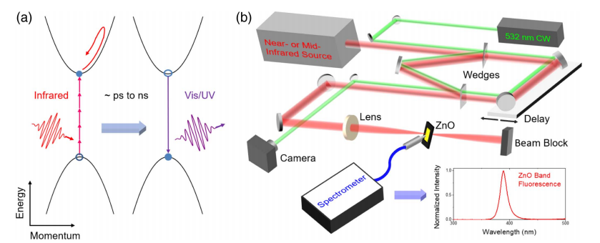Intense, femtosecond laser pulses have for the last several decades been used for studies of ultrafast dynamics in atomic, molecular, and condensed matter systems. More recently, the development of techniques for nonlinear pulse compression to the single-optical-cycle limit and for stabilizing and controlling the carrier-envelope phase (the phase difference between the peak of the pulse envelope and the closest maximum of the oscillating electric field) has enabled the conversion of intense laser pulses into extreme ultraviolet attosecond pulses and ignited the field of attosecond science.
As the scientific goals of the ultrafast and attosecond science communities have grown and evolved, novel laser technologies have been developed to meet the needs of the experiments.
These advances in few-cycle laser source technology have, in turn, necessitated the development of new techniques for characterizing lasers. Historically, techniques based on perturbative nonlinear optics have been widely applied for characterizing the time-or frequency-dependent intensity and phase, which is sufficient to obtain the laser pulse duration and the frequency chirp of the pulse.
Detection of the carrier-envelope phase, however, has required separate measurements which are, in general, not able to resolve the laser pulse's temporal profile. More recently, strong-field laser-matter interactions have been identified as an alternative way to measure the full electric field waveform-including the carrier-envelope phase-of a laser pulse. Several techniques have been demonstrated, which have been based on field ionization of gases, attosecond streak camera, high-order harmonic generation, and other mechanisms.
Both pulse characterization schemes, however, have significant challenges, especially when working with few-cycle lasers in the mid-infrared spectral region. This is due to either the lack of both efficient nonlinear optical crystals and good detectors for the fundamental and second harmonic wavelengths of mid-IR pulses, or the weak intensity of the mid-infrared pulses.
Researchers at the University of Central Florida, led by first author Dr. Yangyang Liu and PI Prof. Michael Chini, have introduced a variation on strong-field pulse characterization techniques which is particularly well-suited for mid-infrared pulse measurements. The relevant results are published in Photonics Research, Vol. 9, Issue 6, 2021 (Yangyang Liu, Shima Gholam-Mirzaei, John E. Beetar, Jonathan Nesper, Ahmed Yousif, M. Nrisimhamurty, and Michael Chini, "All-optical sampling of few-cycle infrared pulses using tunneling in a solid," Photon. Res. 9, 929-936 (2021))
The technique, based on the Tunneling Ionization with a Perturbation for Time-domain Observation of Electric Fields (TIPTOE) technique introduced in 2018 by researchers at Gwangju Institute of Science and Technology, Korea, relies upon tunneling and multiphoton excitation of conduction band electrons in dielectric solids to provide an ultrafast temporal gate for characterizing a weak perturbing pulse, and permits an all-optical detection scheme in which the visible/UV band fluorescence associated with electron relaxation back to the valence band is collected with a spectrometer, as shown in Fig. 1.

Fig. 1 (a) Schematic of strong-field excitation and relaxation via band fluorescence emission in solids. (b) Experimental setup for solid-state TIPTOE using band fluorescence in ZnO.
The team uses this "solid-state TIPTOE" technique to characterize microjoule-level mid-infrared pulses from a tunable optical parametric amplifier, as well as few-cycle pulses compressed from a ytterbium-doped laser amplifier. The solid-state TIPTOE technique eliminates many of the challenges associated with both perturbative nonlinear optical and strong-field characterization techniques.
First, the measurement is based upon the detection of narrow-linewidth band fluorescence emission, a near-universal phenomenon in solids that does not depend on the driving laser wavelength. For ZnO crystals used in the study, the band fluorescence signal is at 390 nm, which is in the optimal range for detection with silicon-based detectors.
Second, the technique does not require phase matching of the nonlinear optical process. Finally, multiphoton excitation in solids requires orders-of-magnitude less intensity than field ionization of gases. For ZnO, an intensity of 1 TW/cm2 was used, while for smaller band gap materials such as Si, an intensity of only 10 GW/cm2 is sufficient.
Furthermore, the use of structured solid-state media offers the potential to adapt the technique to a single-shot geometry. Currently, all techniques for waveform characterization require multi-shot measurements in a scanning geometry. Future work will focus on the realization of single-shot detectors for few-cycle laser waveforms spanning the near- to long-wave infrared.


